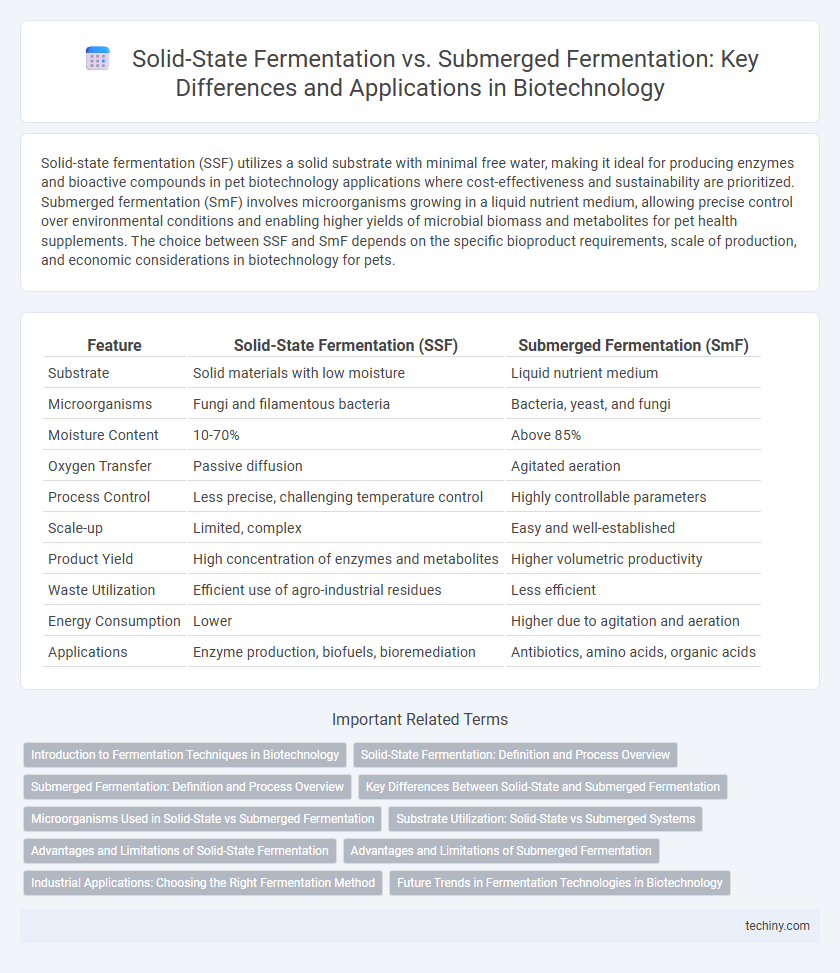Solid-state fermentation (SSF) utilizes a solid substrate with minimal free water, making it ideal for producing enzymes and bioactive compounds in pet biotechnology applications where cost-effectiveness and sustainability are prioritized. Submerged fermentation (SmF) involves microorganisms growing in a liquid nutrient medium, allowing precise control over environmental conditions and enabling higher yields of microbial biomass and metabolites for pet health supplements. The choice between SSF and SmF depends on the specific bioproduct requirements, scale of production, and economic considerations in biotechnology for pets.
Table of Comparison
| Feature | Solid-State Fermentation (SSF) | Submerged Fermentation (SmF) |
|---|---|---|
| Substrate | Solid materials with low moisture | Liquid nutrient medium |
| Microorganisms | Fungi and filamentous bacteria | Bacteria, yeast, and fungi |
| Moisture Content | 10-70% | Above 85% |
| Oxygen Transfer | Passive diffusion | Agitated aeration |
| Process Control | Less precise, challenging temperature control | Highly controllable parameters |
| Scale-up | Limited, complex | Easy and well-established |
| Product Yield | High concentration of enzymes and metabolites | Higher volumetric productivity |
| Waste Utilization | Efficient use of agro-industrial residues | Less efficient |
| Energy Consumption | Lower | Higher due to agitation and aeration |
| Applications | Enzyme production, biofuels, bioremediation | Antibiotics, amino acids, organic acids |
Introduction to Fermentation Techniques in Biotechnology
Solid-state fermentation (SSF) involves microbial growth on moist solid substrates without free-flowing water, making it ideal for producing enzymes, organic acids, and bioactive compounds from agro-industrial residues. In contrast, submerged fermentation (SmF) utilizes liquid nutrient media, enhancing oxygen transfer and temperature control, which suits large-scale production of antibiotics, amino acids, and cell biomass. Both techniques are crucial in biotechnology for optimizing microbial metabolism and metabolite yield under different environmental and operational conditions.
Solid-State Fermentation: Definition and Process Overview
Solid-State Fermentation (SSF) involves the cultivation of microorganisms on solid materials without free-flowing water, typically utilizing agro-industrial residues as substrates. This process supports the growth of fungi, bacteria, and actinomycetes under controlled temperature, humidity, and aeration conditions, promoting enzyme production and secondary metabolites. SSF offers advantages in enhanced product concentration, lower energy consumption, and reduced wastewater generation compared to Submerged Fermentation (SmF).
Submerged Fermentation: Definition and Process Overview
Submerged fermentation involves cultivating microorganisms in a liquid nutrient medium, allowing for precise control of environmental parameters such as pH, temperature, and oxygen levels. This method enhances microbial growth and metabolite production by facilitating uniform nutrient distribution and efficient waste removal. Applications in pharmaceuticals, enzyme production, and biofuels benefit from the scalability and consistency of submerged fermentation processes.
Key Differences Between Solid-State and Submerged Fermentation
Solid-state fermentation (SSF) utilizes solid materials as substrates without free-flowing water, optimizing growth of fungi and filamentous bacteria, whereas submerged fermentation (SmF) involves microbial cultivation in liquid broth with high water content, favoring bacteria and yeast. SSF offers higher product concentration, lower energy consumption, and simpler reactor design, while SmF enables better control of parameters like pH, temperature, and aeration, facilitating large-scale industrial production. Significant distinctions include substrate moisture levels, microbial diversity, oxygen transfer efficiency, and downstream processing complexity between SSF and SmF techniques.
Microorganisms Used in Solid-State vs Submerged Fermentation
Microorganisms used in solid-state fermentation (SSF) primarily include fungi such as Aspergillus and Rhizopus species, which thrive on solid substrates with low moisture content. Submerged fermentation (SmF) predominantly utilizes bacteria and yeast like Bacillus subtilis and Saccharomyces cerevisiae, adapted to liquid nutrient media with high water activity. The distinct microbial metabolic pathways in SSF and SmF impact enzyme production, biomass yield, and bioactive compound synthesis, making microorganism selection critical for process optimization in biotechnology.
Substrate Utilization: Solid-State vs Submerged Systems
Substrate utilization in solid-state fermentation (SSF) involves the growth of microorganisms on moist solid materials without free-flowing water, maximizing the use of agro-industrial residues such as wheat bran or sugarcane bagasse. In submerged fermentation (SmF), microorganisms grow in liquid nutrient-rich media, allowing uniform substrate availability and easier control of environmental parameters. SSF typically exhibits higher substrate conversion efficiency due to localized enzyme-substrate interactions, while SmF offers scalability and consistent mixing for homogeneous nutrient uptake.
Advantages and Limitations of Solid-State Fermentation
Solid-state fermentation (SSF) offers advantages such as higher product yields, lower water and energy consumption, and the ability to use agro-industrial residues as substrates, making it economically and environmentally sustainable. However, SSF faces limitations including challenges in controlling process parameters like temperature and moisture, risk of contamination, and difficulties in scaling up for industrial production. Optimization of aeration systems and substrate preparation is crucial to overcome these constraints in SSF applications.
Advantages and Limitations of Submerged Fermentation
Submerged fermentation offers enhanced control over environmental parameters such as pH, temperature, and aeration, leading to higher product yields and consistency in biotechnological processes. It facilitates easy downstream processing and scalability, making it suitable for large-scale industrial production of enzymes, antibiotics, and biofuels. However, it requires significant energy input for agitation and aeration, along with high water consumption and the risk of contamination due to the aqueous environment.
Industrial Applications: Choosing the Right Fermentation Method
Solid-state fermentation (SSF) is ideal for producing enzymes, biofuels, and organic acids using agro-industrial residues, offering low water consumption and cost-effective scalability. Submerged fermentation (SmF) excels in high-volume production of antibiotics, vaccines, and amino acids with precise environmental control and faster microbial growth rates. Industrial applications demand selecting SSF for robust, low-moisture substrates, while SmF suits processes needing stringent sterility and uniform nutrient distribution.
Future Trends in Fermentation Technologies in Biotechnology
Future trends in fermentation technologies emphasize enhanced solid-state fermentation (SSF) for its low water requirement and higher product concentration, driving sustainable bioprocessing. Innovations in bioreactor design and process control through AI and IoT integration are optimizing submerged fermentation (SmF), increasing yield and reducing production costs for pharmaceuticals and enzymes. Hybrid systems combining SSF and SmF techniques are emerging, aiming to leverage the advantages of both methods for scalable and efficient bioproduct synthesis.
Solid-State Fermentation vs Submerged Fermentation Infographic

 techiny.com
techiny.com